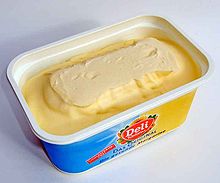Trans fat
This article may not have a worldwide view of the subject. (January 2024) |

Trans fat is a type of unsaturated fat.[1] Trans fat is often produced in factories when manufacturing certain processed foods such as margarine. Trans fat occurs in nature only very rarely, found in small amounts in meat and milk fat. When vegetable oils are heated or when they are hydrogenated, trans fats are made. Hydrogenation is the process of bubbling hydrogen gas through the oil to change its consistency. The bubbling raises the melting point of the oil. As the hydrogen passes through, the oil begins to become solid. By stopping the hydrogenation part of the way through, manufacturers obtain "partially hydrogenated oil". This is similar to butter, but much cheaper to produce. It is sold as "margarine", "oleo" or "vegetable shortening". The process allows cheaply adding a butter-like consistency to food products.
Trans fat is bad for human health and has been linked to a number of problems including: coronary heart disease,[2] cancer, diabetes,[3][4] obesity,[5] liver dysfunction,[6] and infertility.[7] Healthy oils are always liquid at the temperature of blood. Saturated and trans fats are not.
There has yet to be a study which shows that trans fat is good for human health in any way. Since scientists and nutritionists now know the health issues related to eating trans fats, trans fats are being used less but there are still some in commercial food products.
For some time, the US government's Food and Drug Administration allowed makers of food products to label their products as having "0 grams of trans fat per serving" as long as the amount of trans fat in the food product falls below 0.5 grams per serving. Since partially hydrogenated oils are the major source of trans fat, reading the "ingredients" label is the safest way to ensure that a food does not contain any trans fat at all. Fried foods will likely, but not necessarily, contain trans fat since fried foods are produced by using very hot oil.
2015–2018 phaseout in the United States[change | change source]
In 2013, the Food and Drug Administration began to gradually stop the use of trans fats in all foods. It says there is no safe amount of trans fats that should be in food eaten by humans.
In June 2015, the FDA issued a final statement. It says there is no agreement by scientists that artificial trans fatty acids are safe for any use in human food.[8] Trans fat must be taken out of all food production within three years (by June 2018).[9] The FDA says the ban will cost the food industry $6.2 billion over 20 years. The food industry must use new formulas and recipes using ingredients without trans fat. The benefits will be about $140 billion over 20 years. This will be mostly from lower health care costs. Food companies can issue requests to the FDA for permission to use partially hydrogenated oils. The companies must prove the oils' use is safe.[9]
References[change | change source]
- ↑ Kuhnt K, Baehr M, Rohrer C, Jahreis G (October 2011). "Trans fatty acid isomers and the trans-9/trans-11 index in fat containing foods". European Journal of Lipid Science and Technology. 113 (10): 1281–1292. doi:10.1002/ejlt.201100037. PMC 3229980. PMID 22164125.
- ↑ Food and nutrition board, institute of medicine of the national academies (2005). Dietary Reference Intakes for Energy, Carbohydrate, Fiber, Fat, Fatty Acids, Cholesterol, Protein, and Amino Acids (Macronutrients). National Academies Press. p. 504.[permanent dead link]
- ↑ van Dam RM, Stampfer M, Willett WC, Hu FB, Rimm EB (2002). "Dietary fat and meat intake in relation to risk of type 2 diabetes in men". Diabetes Care. 25 (3): 417–424. doi:10.2337/diacare.25.3.417. PMID 11874924.
{{cite journal}}: CS1 maint: multiple names: authors list (link) - ↑ Hu FB, van Dam RM, Liu S (2001). "Diet and risk of Type II diabetes: the role of types of fat and carbohydrate". Diabetologia. 44 (7): 805–817. doi:10.1007/s001250100547. PMID 11508264. S2CID 10989290.
{{cite journal}}: CS1 maint: multiple names: authors list (link) - ↑ Gosline, Anna (2006-06-12). "Why fast foods are bad, even in moderation". New Scientist. Archived from the original on 2007-02-06. Retrieved 2007-01-09.
- ↑ Mahfouz M (1981). "Effect of dietary trans fatty acids on the delta 5, delta 6 and delta 9 desaturases of rat liver microsomes in vivo". Acta Biologica et Medica Germanica. 40 (12): 1699–1705. PMID 7345825.
- ↑ Chavarro Jorge E, Rich-Edwards Janet W, Rosner Bernard A and Willett Walter C (January 2007). "Dietary fatty acid intakes and the risk of ovulatory infertility". American Journal of Clinical Nutrition. 85 (1): 231–237. doi:10.1093/ajcn/85.1.231. PMID 17209201.
{{cite journal}}: CS1 maint: multiple names: authors list (link) - ↑ "Final Determination Regarding Partially Hydrogenated Oils". 17 June 2015.
- ↑ 9.0 9.1 Edney, Anna; Giammona, Craig (16 June 2015). "U.S. Bans Trans Fat". Bloomberg L.P. Retrieved 16 June 2015.
